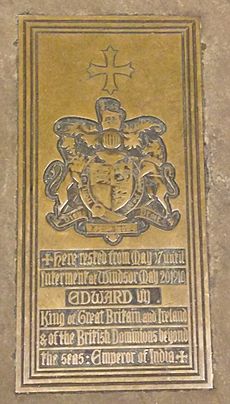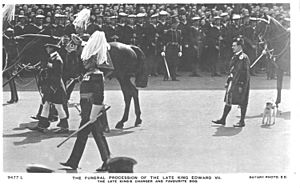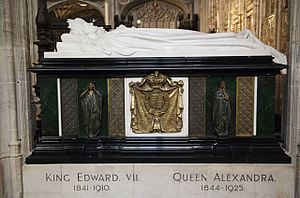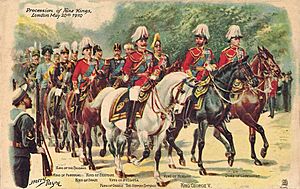Death and state funeral of Edward VII facts for kids

The funeral procession of King Edward VII, passing through Windsor
|
|
| Date |
|
|---|---|
| Location |
|
| Participants | British royal family |
The state funeral of Edward VII, who was the King of the United Kingdom of Great Britain and Ireland and Emperor of India, took place on Friday, May 20, 1910.
This funeral was a truly historic event. It brought together the largest number of European royal family members ever seen in one place. It was also the last such grand gathering before many royal families lost their power during and after the First World War.
| Top - 0-9 A B C D E F G H I J K L M N O P Q R S T U V W X Y Z |
King Edward VII's Final Days
In April 1910, King Edward VII returned to Buckingham Palace from France. He was very ill with severe bronchitis. His wife, Queen Alexandra, came back from visiting her brother in Greece a week later, on May 5.
On May 6, Edward had several heart attacks. But he was determined not to give up, saying he would "work to the end." Even as he felt faint, his son, the Prince of Wales (who would soon become King George V), told him good news: his horse, Witch of the Air, had won a race. The King replied, "Yes, I have heard of it. I am very glad." These were his last words. He lost consciousness around 11:30 p.m. and passed away 15 minutes later.
Queen Alexandra did not want Edward's body moved for eight days. However, she did allow small groups of people to visit his room to say goodbye.
Paying Respects: The Lying-in-State
On May 11, the King was dressed in his uniform. His body was placed in a large oak coffin. On May 14, the coffin was moved to the throne room, where it was sealed and rested privately. This is called "lying-in-state," where the body of an important person is displayed for people to pay their respects.
Then, on May 17, the coffin was taken in a procession to Westminster Hall. Here, the public could come and see it. This was the first time a member of the royal family had a public lying-in-state in Westminster Hall. It was inspired by the public viewing of former Prime Minister William Ewart Gladstone in 1898. A short service was held when the coffin arrived. Choirs sang a hymn requested by Queen Mary, but the military band was so loud it was hard to hear them.

On the first day, thousands of people waited patiently in the rain to pay their respects. About 25,000 people couldn't get in before the gates closed at 10 p.m. On May 19, Emperor Wilhelm II of Germany wanted the hall closed while he laid a wreath. But the police said it might cause problems with the crowd. So, the emperor entered through a different door while the public continued to pass by. It's thought that about half a million people visited the hall over three days.
The Grand State Funeral
"So gorgeous was the spectacle on the May morning of 1910 when nine kings rode in the funeral of Edward VII of England that the crowd, waiting in hushed and black-clad awe, could not keep back gasps of admiration. In scarlet and blue and green and purple, three by three the sovereigns rode through the palace gates, with plumed helmets, gold braid, crimson sashes, and jeweled orders flashing in the sun. After them came five heirs apparent, forty more imperial or royal highnesses, seven queens—four dowager and three regnant—and a scattering of special ambassadors from uncrowned countries. Together they represented seventy nations in the greatest assemblage of royalty and rank ever gathered in one place and, of its kind, the last. The muffled tongue of Big Ben tolled nine by the clock as the cortege left the palace, but on history's clock it was sunset, and the sun of the old world was setting in a dying blaze of splendor never to be seen again."
- Barbara W. Tuchman, The Guns of August
The funeral was held two weeks after the King's death, on May 20. Huge crowds, estimated to be between three and five million people, gathered to watch the procession. About 35,000 soldiers lined the route. The procession started at Buckingham Palace and went to Westminster Hall. There, a small ceremony was led by the Archbishop of Canterbury. Only a small group of close family attended this part, including Queen Alexandra, King George V, and the German Emperor. Thousands of other mourners waited outside the Hall. Big Ben, the famous bell, rang 68 times, once for each year of Edward VII's life. This was the first time it was used this way for a monarch's funeral.
The procession then moved from Westminster Hall through London's streets. It included many important people from 70 different countries. A horseback procession was followed by 11 carriages. The King's favorite dog, Caesar, walked proudly at the front of the procession, just behind the carriage carrying the King's coffin.
From Paddington Station, a special funeral train took the mourners to Windsor. The train was pulled by a locomotive named King Edward. From the station in Windsor, the procession continued to Windsor Castle. A full funeral ceremony was then held in St George's Chapel.
The funeral service was similar to the one for Queen Victoria. However, Edward VII was buried inside the chapel, unlike Victoria. Queen Alexandra specifically asked for a certain song to be sung, but church leaders thought another piece was more serious. So, they sang a chorus from George Frideric Handel's Funeral Anthem For Queen Caroline instead. Alexandra also requested two hymns that the congregation sang, which was a new idea for royal state funerals.
The company that organized the funeral was William Banting of St James's Street, London. This family business had also arranged many other royal funerals, including those for King George III, Queen Victoria, and Prince Albert.
Final Resting Place
Edward's body was first placed temporarily in the Royal Vault at Windsor. Later, in 1919, Queen Alexandra asked for a special monument to be built. This monument, designed by Bertram Mackennal, features white marble statues of the King and Queen on a black and green marble tomb. Both their bodies were placed there in 1927, two years after Queen Alexandra passed away. The monument even includes a small statue of Edward's beloved dog, Caesar, lying at his feet.
Important Guests
The funeral was attended by many important people from around the world. It was a truly unique gathering of royalty.

Many members of the British royal family were there, including Edward's widow, Queen Alexandra, and his son, King George V.
Kings, queens, princes, and princesses from across Europe came to pay their respects. This included the German Emperor, the King of Spain, the King of Denmark, and the King of the Hellenes. Even the Dowager Empress of Russia attended.
Important leaders from countries outside Europe also came. The former President Theodore Roosevelt represented the United States. The Foreign Affairs Minister represented the French Republic. Many other high-ranking officials and nobles from Britain and other nations were present, showing the global importance of King Edward VII.
See also
- Death and state funeral of Queen Victoria
- Death and state funeral of George V
- Death and state funeral of George VI
- Death and state funeral of Elizabeth II
- State funerals in the United Kingdom
Images for kids
-
A plaque in Westminster Hall commemorating the lying in state
-
Contemporary photograph showing 'the late King's charger and favourite dog' walking in front of his coffin in the State funeral procession.
-
The Nine Sovereigns at Windsor for the funeral of King Edward VII, photographed on 20 May 1910. Standing, from left to right: Haakon VII of Norway, Ferdinand of Bulgaria, Manuel II of Portugal, Wilhelm II of Germany, George I of Greece and Albert I of Belgium. Seated, from left to right: Alfonso XIII of Spain, George V of the United Kingdom and Frederick VIII of Denmark.














